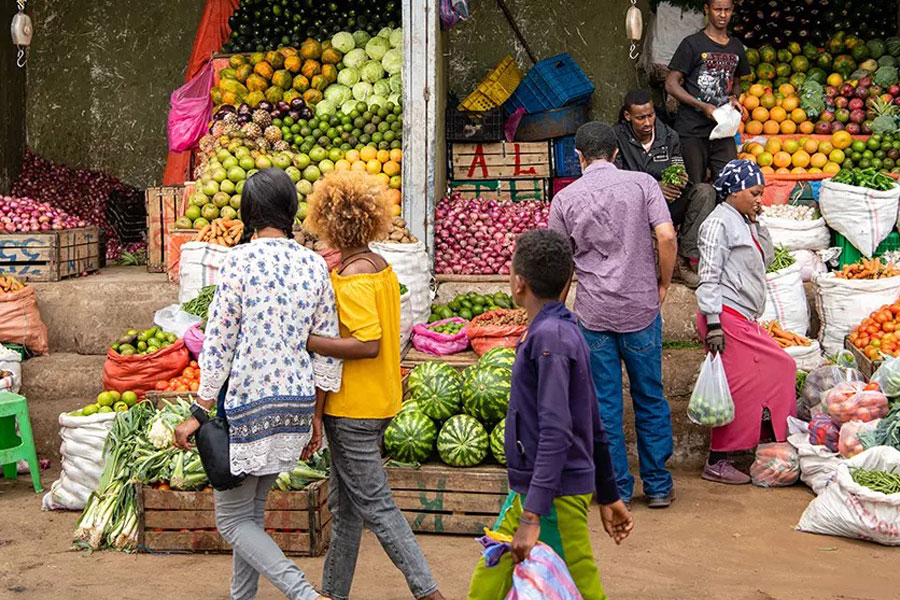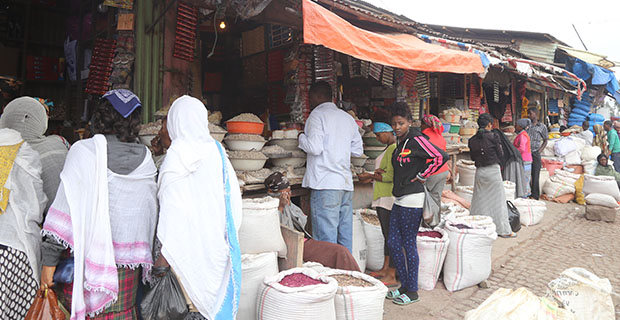
Jul 24 , 2021.
There was an alarming increase in the price of Teffin August 2017. It suddenly skyrocketed from 2,000 Br a quintal to a whopping 3,000 Br. It was unexpected and put a burden on consumers, which had to go deeper into their savings to buy the most important staple grain.
In retrospect, it was not the worst of times. Now, consumers are coughing up at least 5,000 Br for a quintal of the grain, even for the kind that is considered lesser quality, brown Teff. For every 10pc increase in the grain’s price, consumers lose two percent more of their weekly food budgets, with urban residents being the worst hit, a survey by Yanghao Wang and Metin Cakir in 2010 discovered. The two researchers had analysed the impacts of an increase in the price of Tefffor the journal Agricultural Economics.
Imagine then a two-fold increase over the past three years.
It is not just Teff. Last month’s headline inflation reached 24.5pc, a nine-year high. But it was not an outlier for the past two years, where it hovered around 20pc.
The significance of June’s inflation rate shows the problem is not abetting. If it is not addressed urgently, it could very well morph into hyperinflation - inflation typically over 50pc - as the Birr loses ground as a store of the value of goods and services. The dollarisation of the economy has begun long ago with real estate companies quoting house values in dollar terms and tenants for high-end properties paying in a foreign currency.
The culprits are well known. The easiest to track is the depreciation of the Birr against a basket of major currencies. Banks are selling a dollar for 45 Br, from just 32 Br back in January 2020. For an import-dependent economy, every good imported, including raw materials, cost about 40pc higher than at the start of 2020. The Birr is overvalued - too much money in the economy chasing too few goods and services.
No less crucial are the cuts to subsidies over the years, including basic provisions, such as electricity and fuel. It was not sustainable. It is also logical for the administration to reduce state subsidies as both would increase with the economy and the population growing. The state could not have continued to subsidise them forever. Policy wonks in the previous administrations knew that a day of reckoning would someday come.
On their own, the policies by the administration of Prime Minister Abiy Ahmed should be supported. It is only the wisdom of pushing through with such structural corrections in a time of deep social and political upheavals questionable.
The short-term inflationary impact of such policies are well known but they offer the best chance at long-term macroeconomic stability and resilience.
Unfortunately, the administration is not following the medicine it has prescribed for itself: contractionary monetary policy. The Finance Ministry is still borrowing from the National Bank of Ethiopia (NBE), and the latter is complying with the requests. Annual money growth is 28pc of the GDP, way above the 17pc recommended by the IMF. This is only exasperated by the non-productive spending on the war front in the Tigray Regional State. Spending above 100 billion Br - the cost of the war thus far - puts an undue impact on fiscal policy. The administration cannot mobilise nearly enough taxes to cover a year's budget, and development partners have turned their backs. The latest was aid suspension of over 100 million euros by the German government.
This is not to mention the humanitarian toll of the war in Tigray.
The disconnect between the political and economic directions needs to be reconciled. Depreciating the Birr to its real value and cutting burdensome subsidies could work if they are combined with fiscal discipline. The administration cannot have its cake and eat it too. The mixture of a Birr that continues to slide in value and higher money growth in circulation is a one-way road, and that is the cruel economic phenomenon of hyperinflation.
All of these, however, leave one thing insufficiently addressed. With all of the money printed and the higher costs of imports, from more expensive exchange rates to globally rising shipping rates, it is evident why non-food items had in June an inflationary rate of 19pc. These are items more likely to be imported or, in the case of construction materials, to use raw materials sourced from overseas markets.
But what does such high food inflation explain, which reached 28.7pc last month? It is undoubtedly a victim of an increase in money supply, but why is it much worse than non-food items, especially as it should not suffer similarly from the impacts of imported inflation?
The past year has seen its fair share of challenges for the agricultural sector, such as flooding, desert locust invasion and conflict, all of which disrupt harvesting and the supply chain. But most of the food in Ethiopia is sourced locally. Thus, it should not implode in price as, say, imports of electrical products. Even agro-processing plants, such as three industrial-scale edible oil plants inaugurated this year, and a huge bakery, are not making a dent in prices.
Food inflation and insecurity owe themselves just as much to an inefficient agricultural sector as they do to expansionary monetary and fiscal policies. It starts with lacklustre agricultural yields, mainly as a result of the use of poor farming techniques. Changing this requires empowering farmers financially, which is hard to do when they lack access to credit. While there are efforts to allow farmers to use their harvest inventory as collateral to access credit from banks, this effort fails in the face of little to non-existent practice of contracting agreements between wholesalers and farmers. This has been impossible with atomised retailers and middle-persons that dominate the market instead of a modern wholesale system. The latter's absence means that farmers are left without guarantees for their harvests, thus unable to take risks and improve their yields.
Neither is post-harvest losses helping.
Post-harvest loss of maise, wheat, haricot bean, and sorghum is between 14pc to 27pc, according to the UN's Food & Agriculture Organisation (FAO). In Dire Dawa, in 2018, farmers lost nearly half of all their harvested tomatoes, due to a lack of market information, leading to over- or under-production and poor post-harvest storage facilities and technologies.
The combination of neglected supply chains and insufficient investments in smallholder farmers with a general growth of the money supply in the economy and the depreciation of the Birr is an explosive cocktail for economic disaster. Left to themselves for long, they are bound to bankrupt the economy and exasperate food insecurity even further.
PUBLISHED ON
Jul 24,2021 [ VOL
22 , NO
1108]

Radar | May 08,2021

View From Arada | Jul 15,2023

Fortune News | Jun 07,2020

Fortune News | May 04,2019

Fortune News | Nov 04,2023

Photo Gallery | 178738 Views | May 06,2019

Photo Gallery | 168934 Views | Apr 26,2019

Photo Gallery | 159776 Views | Oct 06,2021

My Opinion | 137107 Views | Aug 14,2021

Dec 22 , 2024 . By TIZITA SHEWAFERAW
Charged with transforming colossal state-owned enterprises into modern and competitiv...

Aug 18 , 2024 . By AKSAH ITALO
Although predictable Yonas Zerihun's job in the ride-hailing service is not immune to...

Jul 28 , 2024 . By TIZITA SHEWAFERAW
Unhabitual, perhaps too many, Samuel Gebreyohannes, 38, used to occasionally enjoy a couple of beers at breakfast. However, he recently swit...

Jul 13 , 2024 . By AKSAH ITALO
Investors who rely on tractors, trucks, and field vehicles for commuting, transporting commodities, and f...

Oct 25 , 2025 . By YITBAREK GETACHEW
Officials of the Addis Abeba's Education Bureau have embarked on an ambitious experim...

Oct 26 , 2025 . By YITBAREK GETACHEW
The federal government is making a landmark shift in its investment incentive regime...

Oct 29 , 2025 . By NAHOM AYELE
The National Bank of Ethiopia (NBE) is preparing to issue a directive that will funda...

Oct 26 , 2025 . By SURAFEL MULUGETA
A community of booksellers shadowing the Ethiopian National Theatre has been jolted b...